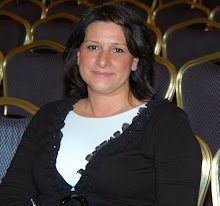


I am just quickly responding to Andrew’s recent post before I have to begin an Initial Consultation.
The post titled: 'We all have an angel within us' – András Pető
Isn’t it interesting to note that the Conductive Education Introductory Training Courses I run I always start in a following way?
When Michelangelo was asked, how did you make the statue of this beautiful angel from this peace of marble? His answer was:
‘ I saw the angel in the marble and carved until I set him free.’
Michelangelo
The above pictures we look at are self-explanatory to some, but we dig deeper and deeper and discuss the little girl’s image from the physical, emotional and psychological point of view… and so on.
... And at the end we always find the angel together...
http://andrew-sutton.blogspot.com/2008/11/we-all-have-angel-within-us-andrs-pet.html
















7 comments:
Judith
You with all these pictures can show that IT IS POSSIBLE. I believe in Conductive Education! Thanks for visiting my blog, i am always around as well.
With love,
Leticia
Szia Judit!
Eloszoris szeretnek gratulalni a bloghoz. Igy tovabb!
Megjegyzesemet azert irom magyarul, mert nem nagyon szeretnem kozhirre tenni es inkabb kerdezni szeretnem. A post elso kepehez irtad: Professor Peto stb., ahogy mindenki hivta ot. Tudod nagy tiszteloje vagyok annak, amit elinditott, megis olyan fura, hogy hogy is hivtak. Semmilyen bizonyitekat sem talaltam annak, hogy valoban professzor lett volna. Te ezt hogy tudod? Ez talan egy magyar szokas volt, hogy akit tiszteltek es dr. volt a neve mellett, gyakran hivtak professzornak.
Szia Laci,
Jo reggelt. Remelem jol vagytok. Koszonom a kedves szavaidat.Nyugodtan irhattad volna Angolul is a kerdesedet. Az evek soran tobbszor olvastam Peto Andras neve mellett a professzor megjelolest.
Peldaul az egyik Intezet altal publikalt konyvben amit a Peto 100 eves szuletsnapjara nyomtattak ki Budapesten 1994 Szeptembereben. A konyv cime: Peto Andras (1893-1993) Megemlekezes Peto professzorra cim alatt
Dr. Hari Maria a Nemzetkozi Peto Intezet Foigazgatoja a 33 oldalon ezt irja " Aki tisztelte es ismerte Peto professzort tudja, hogy O onzestelenul egy eszmeert aldozta az eletet, hogy a kituntetest, szemelye meltatasat elutasitotta a helyett a halozat kialakitasat kovetelte meg. "
Koszi. Valaszodbol is tehat tetten erheto, hogy a tisztelet az onzetlen munka elott krealta a 'professzor' titulust. En is nagyra becsulom es csodalattal adozom kivallo munkassaga elott. Ellenerzeseim nincsenek a megnevezessel kapcsolatban - marcsak tiszteletbol sem, viszont nekem, mint kezdo kutatonak, meg kell maradjak a realis valosagnal irasaimban. Ezert is kerdeztelek teged is. Ahol a titulus fogalmanak valos ertelmezeseben professzor lehetett volna az a Barczi Gusztav vezette gyogypedagogia intezet volt. Ott azonban nem lehetett professzori rangra kerulni, ahogy senki sem volt az, Barczi sem.
Izgalmas, hogy miota Hari doktorno elment es szerencsere az elozo vezetoi era is elmult, mennyire tortenelmi lett az elozo tiz ev is :) Sok sikert Laci
Az elozo valszommal azt szerettem volna a tudtodra adni, hogy a Peto halalanak100 eves efrordulojara kinyomtatott publikacioban is (de nem csak abban) Dr. Hari, professzorkent nevezte Petot. Lehet, hogy tiszteletbol, lehet, hogy azert mert a Peto jogosan megkapta ezt a cimet. Egy ilyen fontos megemlekezes alkalmakor szerintem tobben atkellet, hogy nezzek es cenzurazniuk kellet a kinyomtatott szovegeket. Te hol probaltal kutatni?
Judith,
Although I think Andrew ment something else by saying "are we missing something here?" I still would like to relate to your response:
‘ I saw the angel in the marble and carved until I set him free.’
Michelangelo
Why do I like it?
Orthofunction is a product of interactional relationships between a person and the environment.
This phrase emphasises our responsibility of changing not only the child, but the environment as well. 'Curving the marbel'is the reconstruction of the context in which the child lives in, in fact constructing the upbringing environment.
Only if we did our educational mission in both sphares, the child and the environment, a real change may occur.
Rony Schenker
Tsad Kadima, Israel
I am so sorry Judit not to answer earlier. I did not realise your answer - question. I did a broad literature review and looked into the historical events.
Laci
Post a Comment